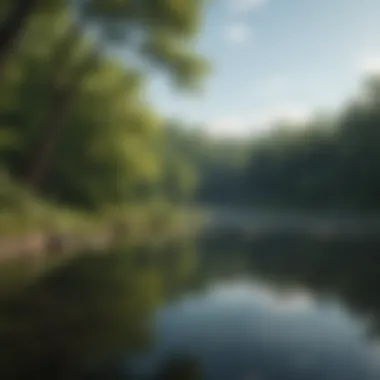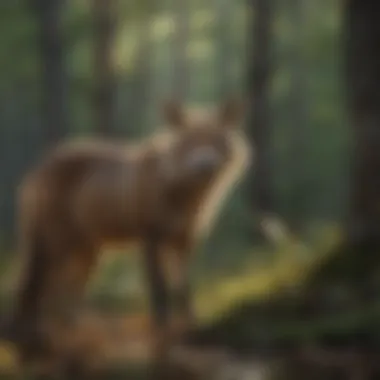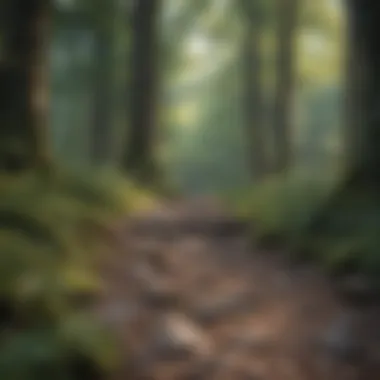Exploring Nature Near New York City: A Comprehensive Guide


Intro
New York City, often seen through the lens of towering skyscrapers and bustling streets, possesses a unique charm in its natural landscapes, which exist in striking contrast to its urban environment. Surrounded by an assembly of parks, preserves, and rivers, the area invites exploration of its diverse ecosystems. This guide aims to illuminate the rich biodiversity found in these natural habitats, providing insights into the wildlife species that inhabit them.
As we discuss the ecosystems neighboring the city, it is paramount to understand not only the importance of these environments but also the conservation efforts underway to protect them. By fostering a deeper appreciation and respect for these ecosystems, we can collectively contribute to their preservation.
Fascinating Facts About the Animal
Unique Characteristics
The wildlife near New York City is as diverse as it is unique. Species such as the Eastern Grey Squirrel, with its remarkable adaptability, thrive in both urban and rural settings. They possess bushy tails that serve multiple purposes, including balance and warmth during the colder months. The Red-tailed Hawk, common in these regions, showcases powerful wings adapted for soaring.
Interestingly, some species exhibit remarkable coloration. The Monarch butterfly, for instance, is famed for its vibrant orange wings with black and white markings, making it easily recognizable in gardens and parks.
Extraordinary Abilities
Birds such as the Peregrine Falcon possess extraordinary speed, reaching up to 240 miles per hour during dives, making them the fastest animals on the planet. Meanwhile, the common raccoon showcases impressive problem-solving skills, demonstrating agility and adaptability. By utilizing their nimble front paws, they can unfasten locks and open containers, showcasing intelligence in the wild.
Behavior and Habitat
Natural Habitats
The natural surroundings of New York City encompass a variety of habitats. The salt marshes along the coast play a crucial role in supporting bird populations, while the woodlands in areas such as Van Cortlandt Park provide sanctuary for numerous small mammals and flora.
Wetlands, like those found in Jamaica Bay, act as breeding grounds for various species, promoting biodiversity and ecological balance. Each habitat contributes significantly to the overall health of local ecosystems.
Social Structures
Wildlife in these areas often exhibits fascinating social structures. For instance, Eastern chipmunks are known for their solitary behavior, while other species such as Canada geese exhibit strong family bonds. These social dynamics are essential for survival, influencing feeding habits and migration patterns.
Recent Scientific Discoveries
Latest Research Findings
Scientific studies in the region have provided valuable insights into animal behavior and conservation strategies. Research conducted by institutions like the New York City Audubon reveals the correlation between urban green spaces and bird migration patterns, indicating the critical role parks play in sustaining wildlife.
Breakthroughs in Animal Biology
Recent findings have also shed light on animal adaptation. Understanding how species like the Eastern Painted Turtle have modified their hibernation processes in response to climate change demonstrates the resilience of wildlife, adapting to shifting environmental conditions.
Cultural Significance
Animals in Folklore
The animals residing near NYC are not only ecologically important but also woven into the cultural fabric of the region. Many species have significance in local folklore. For instance, the tale of the ‘New York Coyote’ serves as a reminder of the ongoing encroachment of wildlife into urban life, embodying a colorful narrative of coexistence.
Influence on Art and Literature
Wildlife has significantly influenced art and literature within the city. The depiction of local species in the works of authors and artists reflects the public's fascination with nature. For example, the iconic image of the American Bald Eagle has become synonymous with the spirit of America itself, symbolizing freedom and resilience.
"Nature is not a place to visit. It is home." — Gary Snyder
As this guide unfolds, we will delve deeper into specific natural areas, discover unique wildlife, and explore activities that allow for a fulfilling experience in the natural world surrounding New York City. Let us engage with these ecosystems, appreciating the beauty they hold, while understanding our role in their preservation.
Preamble to Nature Near New York City
The surrounding environment of New York City, rich in biodiversity and varied landscapes, plays a crucial role in the identity of this urban area. As residents and visitors often seek a refuge from the concrete jungle, exploring the natural spaces near the city offers both physical and psychological benefits. The proximity to greenery and wildlife has an impact on the well-being of individuals, fostering connection with the ecosystem and promoting an active lifestyle.
Urban vs. Natural Landscapes
New York City is known for its iconic skyline and urban infrastructure. However, it also features numerous green spaces that provide a contrasting experience to city life. Urban landscapes can feel overwhelming, with limited access to nature. In contrast, natural landscapes offer tranquility and rejuvenation. Within a short distance from the city, one can find remarkable parks and reserves characterized by forests, wetlands, and meadows. These areas are essential as they facilitate recreational activities such as hiking, birdwatching, and photography. They serve as vital escapes that enhance mental health and overall quality of life.


Importance of Biodiversity
Biodiversity refers to the variety of life forms within a given ecosystem. In areas near New York City, this diversity encompasses a range of species, from native plants to various wildlife. Preserving these natural habitats is not only crucial for maintaining ecological balance, but it also supports species survival. High biodiversity contributes to resilient ecosystems that can withstand environmental changes. Understanding the importance of biodiversity involves recognizing that every species plays a role in the ecosystem’s function and stability. Protecting these natural environments enhances the ability to learn from and appreciate wildlife, fostering a deeper connection to nature.
New York City’s Green Spaces
New York City is often seen as a concrete jungle, yet it is home to an abundance of green spaces that serve as vital lungs for the metropolis. These parks and natural areas provide numerous benefits to residents and visitors alike. They act as essential habitats for wildlife, spots for recreation, and sources of relief from urban stress. In the hectic pace of city life, these oases offer a much-needed retreat, connecting people with nature and fostering a sense of community.
Central Park: An Urban Oasis
Central Park stands as a symbol of urban green space and is perhaps the most iconic park in the country. Covering 843 acres, it provides a wide variety of environments, from meadows to woodlands. The park acts as a sanctuary for local wildlife, offering habitats for more than 200 bird species, as well as other animals such as squirrels, rabbits, and coyotes. Many residents enjoy jogging, cycling, or just lounging on the grass, making it a hub of outdoor activity. Central Park is not only a recreational area; it plays a key role in improving air quality and reducing heat, making it an important part of New York City's ecosystem.
Prospect Park: Nature’s Playground
Prospect Park, designed by the same architects as Central Park, is a less crowded but equally beautiful alternative. Spanning 585 acres, it features extensive woodlands, a serene lake, and well-maintained trails. The park serves as a home to various species including turtles, deer, and many birds. Families often flock to this park for picnics and playtime, especially during warmer months. Its design incorporated elements of the original landscape, allowing visitors to feel immersed in nature while remaining in the city. Aside from being an escape, Prospect Park is crucial for community engagement and education about local flora and fauna.
The High Line: A Linear Park
The High Line is a unique green space built on a former elevated railway. Stretching for 1.45 miles, it showcases gardens and art installations while providing stunning views of the city and the Hudson River. The High Line exemplifies urban renewal and sustainable design, offering a habitat for birds and other wildlife in an otherwise bustling area. Visitors experience a blend of art, architecture, and nature as they walk its pathway. The park has also heightened awareness about the significance of preserving green spaces within urban environments. It encourages community involvement through events focused on environmental education and stewardship.
"New York City's parks are not just lungs for the city but also places where nature and community thrive together."
In summary, New York City’s green spaces serve multiple functions. They provide habitats for a variety of wildlife, promote physical activity, and enhance the quality of life. Each park, from Central Park to the High Line, contributes uniquely to the city's fabric, cultivating appreciation for nature and encouraging responsible stewardship among its visitors.
Nearby Nature Reserves
Nearby nature reserves provide essential escapes from the bustling atmosphere of New York City. These areas not only offer refuge for diverse wildlife but also present opportunities for recreation, education, and conservation. Their proximity to the urban environment makes them accessible for a variety of visitors, whether they are families seeking a day out in nature, wildlife biologists conducting research, or veterinarians understanding local ecosystems. The ecological significance of these reserves cannot be overstated, as they serve as critical habitats for many species and work as buffers against the impact of urbanization.
Gateway National Recreation Area
The Gateway National Recreation Area encompasses a rich blend of ecosystems, comprising wetlands, dunes, and historical sites. Situated at the mouth of New York Harbor, this area is vital for migratory birds and marine life. The diverse habitats here make it an excellent spot for nature enthusiasts.
Visitors can engage in various activities such as hiking, fishing, and birdwatching. Notably, the Sandy Hook unit offers stunning coastal views and pristine beaches.
Key features include:
- Biodiversity: Home to over 300 species of birds, including various shorebirds.
- Recreational opportunities: Designated areas for biking and picnicking enhance the visitor experience.
- Educational programs: Regularly scheduled ranger-led tours provide insights into the local ecosystem and conservation efforts.
Jamaica Bay Wildlife Refuge
Jamaica Bay Wildlife Refuge is renowned for its expansive wetlands, making it a critical stopover point for migratory birds during their annual journeys. This refuge is part of the larger Gateway National Recreation Area but deserves individual attention for its unique characteristics.
The refuge features over 9,000 acres of diverse habitats, including salt marshes, tidal creeks, and woodlands. This rich ecosystem attracts a variety of wildlife. Birdwatching is particularly popular here, with visitors often spotting egrets, ospreys, and even the endangered black-crowned night-heron.
Highlights of Jamaica Bay include:
- Nature trails: Designed for easy access, these trails allow for close observation of habitats.
- Visitor center: A hub for educational materials and exhibits on local wildlife.
- Photography spots: Several locations are optimal for capturing stunning images of birds and landscapes.
Harriman State Park
Harriman State Park presents another remarkable escape from city life, known for its vast wooded areas and over 200 miles of hiking trails. Located just north of the city, this park is a significant natural area that attracts outdoor enthusiasts year-round.
The park's varied terrain offers something for everyone, from casual walkers to experienced hikers. There are numerous lakes and streams that support additional recreational activities, such as fishing and kayaking. Additionally, its proximity to New York City makes it a convenient destination for day trips.
Notable aspects of Harriman State Park include:
- Wildlife diversity: Supports populations of deer, foxes, and a wide range of bird species.
- The Long Path: A long-distance trail that enhances the hiker's experience through changing landscapes.
- Seasonal activities: Winter offers opportunities for snowshoeing and cross-country skiing.
Investing time in exploring nearby nature reserves is crucial for understanding the intricate balance of urban and natural environments, enhancing both personal well-being and ecological integrity.
The preservation of these areas is essential not only for the wildlife that inhabit them but also for humanity's connection to nature. By visiting these reserves, individuals can appreciate the role these ecosystems play in the broader context of environmental sustainability.
Wildlife Observation and Activities


Wildlife observation and activities are crucial for understanding the natural ecosystem surrounding New York City. These activities allow individuals to connect with the diverse species that inhabit both urban parks and the nature reserves nearby. Not only does this promote a greater awareness of local wildlife, but it also encourages conservation efforts. Activities such as birdwatching, wildlife photography, and hiking are accessible and can be enjoyed by anyone, from families to seasoned naturalists. They provide a unique opportunity to escape the urban environment and appreciate the beauty and complexity of nature. Engaging in these pursuits can enhance stress relief and promote physical well-being.
Birdwatching Opportunities
Birdwatching serves as one of the most popular forms of wildlife observation in the New York City area. This region is a sanctuary for various bird species, some of which migrate through the area, making it a rich ground for observation. Locations like Central Park, Jamaica Bay Wildlife Refuge, and even Prospect Park are known for their birdwatching potential. Observers may spot anything from common sparrows to more elusive species like the black-crowned night heron.
Some practical considerations must be kept in mind while birdwatching:
- Best Times: Early morning and late afternoon are ideal for seeing more activity.
- Equipment: A good pair of binoculars and a field guide can enhance the experience.
- Patience: Quiet observation is key in not scaring away birds.
Birdwatching nourishes a connection to nature and offers insight into the behavior and habitats of various avifauna.
Wildlife Photography Spots
Photography of wildlife provides a visual record of the area's ecological diversity and can inspire others to engage in conservation. Places like the High Line and various state parks offer unique vantage points for photography. Capturing images of animals in their natural surroundings can be incredibly rewarding but requires awareness of ethics in wildlife photography.
Here are some popular spots:
- Harriman State Park: Known for its lush landscapes and varied wildlife.
- Sheep Meadow in Central Park: Provides an excellent background for shots of squirrels and birds.
- Jamaica Bay: Offers a variety of landscapes ideal for capturing migratory birds.
Considerations for wildlife photography include:
- Know the Rules: Some areas have restrictions to protect the species.
- Respect Wildlife: Don't approach animals too closely; use zoom lenses.
Hiking and Nature Trails
Hiking offers a direct method to experience nature, combining exercise with exploration. There are multiple trails both within the city and in nearby reserves that highlight various ecosystems. These trails vary in difficulty and length, catering to families, casual walkers, and serious hikers alike.
Notable hiking areas include:
- Appalachian Trail: Starts just north of the city, offering miles of hiking.
- Palisades Interstate Park: Features trails with stunning views of the Hudson River.
- Central Park: Provides well-maintained paths ideal for beginners.
When planning a hike, it is valuable to consider:
- Trail Conditions: Weather can affect safety and accessibility.
- Preparation: Bring adequate supplies including water, snacks, and a map.
- Respect Nature: Stay on marked trails to minimize impact on the environment.
Engaging in these wildlife observation activities fosters a deeper appreciation of the natural world. Individuals can cultivate a sense of wonder while also supporting conservation efforts.
Seasonal Changes and Their Impact
Seasonal changes play a crucial role in understanding the dynamics of wildlife and natural environments near New York City. Each season offers unique opportunities and challenges for both flora and fauna, influencing their behaviors, reproductive cycles, and food availability. Understanding these changes is essential for nature enthusiasts, wildlife biologists, and families exploring the natural world. Awareness of seasonal variations not only enhances outdoor activities but also informs conservation efforts aimed at protecting ecosystems and the species that inhabit them.
Spring: Awakening of Wildlife
Spring marks a period of renewal and growth. As temperatures rise, many species emerge from dormancy. Animals such as deer and various bird species reappear, engaging in courtship and nesting behaviors. The migratory birds return, bringing vibrant colors and melodies back to urban parks and nature reserves. The blossoming plants and flowers provide essential food sources for pollinators like bees and butterflies, which are also increasingly active during this time.
"Spring in the Northeast is characterized by a specific timing of events, known as phenology, which is critical for stability in ecosystems."
The transformation in the ecosystem requires attention to which species are returning and how they adapt to the changing environment. Knowing the timing and species can help in planning wildlife observing events.
Summer: Peak Biodiversity
Summer is when biodiversity reaches its zenith. The warm weather fosters an abundance of life; habitats teem with insects, birds, and mammal activity. This season becomes ideal for hiking, camping, and observing nature. The lush green foliage provides shade and habitat, while flowers attract various pollinators.
Common sighting during summer include:
- Young birds learning to fly
- Deer fawning in the underbrush
- Numerous amphibians active in wetlands
While this season presents opportunities for outdoor exploration, it also brings challenges. High temperatures can stress wildlife, particularly in urban settings where heat islands form. Monitoring these conditions helps in wildlife management and planning conservation efforts.
Autumn: Migration and Changes


Autumn is a time of transformation, with many species preparing for the changes ahead. Birds partake in migrations, seeking warmer climates before winter. This season showcases stunning color change in foliage, creating a beautiful landscape, especially in parks like Harriman State Park.
As temperatures drop, animals begin their preparations:
- Squirrels gather nuts for winter.
- Bears enter a phase of hyperphagia, increasing their food intake.
- Many mammals begin to grow thicker fur as insulation against the impending cold.
Visiting during this time offers a unique viewing experience, particularly for birdwatchers looking to observe migration patterns.
Winter: Adapting Wildlife
Winter presents a vastly different scene. Many animals enter hibernation or reduce their activity significantly. However, some species adapt to cold weather and remain active. For instance, certain birds can be seen foraging for seeds or berries in parks.
Strategies that wildlife employs include:
- Hibernation in bears and some reptiles
- Migration of bird species to warmer areas
- Changes in diet for many mammals, leading to foraging behaviors
The stark beauty of winter landscapes also makes for compelling outdoor experiences. Understanding animal behavior during this season can assist in recognizing tracks and identifying wildlife even in the snow.
Living in harmony with nature necessitates profound ecological understanding tailored to each seasonal shift. Seasonal changes are not merely transitions; they shape the lifecycles of countless organisms and the narratives of ecosystems, directly influencing conservation priorities.
Conservation Efforts and Challenges
Conservation is a vital aspect of maintaining the delicate balance between urban development and wildlife preservation. The transition from nature-filled expanses to concrete jungles challenges many ecosystems surrounding New York City. By understanding the conservation efforts and the obstacles in their way, we can ensure a sustained environment for both humans and wildlife alike.
Protecting Natural Habitats
Natural habitats are crucial for wildlife. These areas provide food, shelter, and breeding grounds for many species. In and around New York City, various initiatives aim to protect these spaces. The protection of habitats reduces the risk of extinction for numerous species while promoting biodiversity.
Efforts include the establishment of parks like Harriman State Park and Jamaica Bay Wildlife Refuge. These areas preserve local flora and fauna while providing a sanctuary for threatened species. Furthermore, measures to restore habitats that have been degraded are equally important. Restorative practices, such as reforestation and invasive species control, assist in revitalizing ecosystems.
Endangered Species Initiatives
Endangered species programs focus on species at risk of extinction. In New York City, various organizations work to support these initiatives. They monitor populations, promote breeding programs, and educate the public about the importance of these species. For example, the New York State Department of Environmental Conservation runs programs dedicated to species like the Piping Plover and Eastern Box Turtle.
Conservationists assess the threats that affect these species, which include habitat loss, pollution, and climate change. Initiatives that encourage community involvement are essential, as they raise awareness and forge connections between local residents and wildlife. Program successes often hinge on community engagement and participation.
Community Involvement in Conservation
Community involvement is a driving force in successful conservation efforts. Local residents can play an active role simply by participating in educational programs and volunteering for conservation projects. Collaborative efforts between non-profits, schools, and government bodies help educate citizens about the natural world around them.
Effective conservation relies on local knowledge and commitment. Examples of successful community initiatives may include tree planting events or clean-up drives in nearby parks and wildlife areas. Social media platforms can enhance outreach, allowing groups to share their experiences and recruit new volunteers.
"The engagement of community members can create a powerful network of advocates for conservation, ensuring that efforts are sustained and effective."
In summary, conservation efforts surrounding New York City have remarkable potential to protect natural habitats, support endangered species, and foster community involvement. These elements are crucial to combat the ongoing challenges that threaten the ecosystem, providing a sustainable future for wildlife amid urban development.
Closure: Nature's Importance to Urban Life
Nature plays a crucial role in urban settings, particularly in a bustling metropolis like New York City. It serves not only as a refuge from the chaos of city life but also as a vital component for mental and physical well-being. Access to green spaces and natural environments provides numerous benefits. This section details two key aspects: promoting wildlife education and fostering a connection to nature.
Promoting Wildlife Education
Wildlife education is essential for fostering a sustainable relationship between urban residents and their environment. Educating individuals about local species and their habitats raises awareness about biodiversity. Programs at parks like Central Park and Jamaica Bay Wildlife Refuge offer valuable insights on species that inhabit these areas.
- Importance of Awareness: Understanding wildlife contributes to better conservation efforts. When people know more about the creatures around them, they are more likely to protect their habitats.
- Community Engagement: Workshops, guided tours, and educational materials can enhance knowledge of ecological systems. Local schools often partner with environmental organizations to promote outreach activities that highlight wildlife education.
- Use of Technology: Innovative approaches, like mobile applications or social media platforms, have emerged to provide real-time data on local wildlife sightings, promoting active participation in wildlife observation.
Educational efforts shape how urban dwellers perceive their surroundings, thus advancing conservation efforts on a broader scale.
Fostering a Connection to Nature
Creating a connection to nature is indispensable, especially in an urban context filled with technology and concrete. Engaging with nature elicits profound emotional and psychological benefits.
- Mental Health Benefits: Studies demonstrate that spending time outdoors reduces stress, improves mood, and enhances overall mental health. Natural settings promote relaxation and tranquility, vital for urban residents facing daily stresses.
- Physical Activities: Parks and nature reserves offer various activities such as walking, cycling, and birdwatching. These activities encourage an active lifestyle and help combat health issues linked to sedentary living.
- Cultural Significance: Nature also has cultural relevance. Many communities share traditions rooted in the natural landscapes surrounding them. This fosters respect and appreciation for local ecosystems among residents, inviting active participation in their care.
"Connecting with nature in urban environments fosters well-being and enhances urban life quality."
Ultimately, nurturing a relationship with nature benefits both individuals and the community. It cultivates a society that values and protects its natural resources, ensuring those spaces remain accessible for future generations.
In summary, the connection between nature and urban life is essential. It contributes to wildlife education and instills a sense of belonging that is vital for a thriving society.







